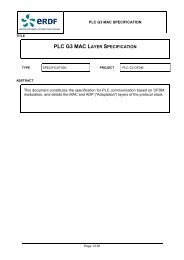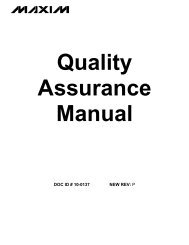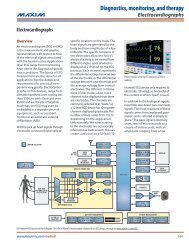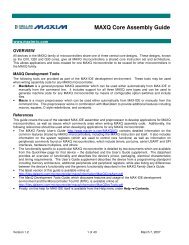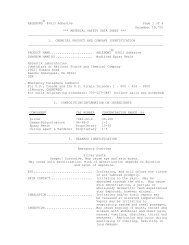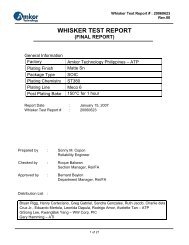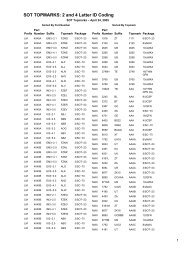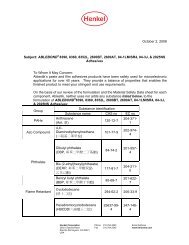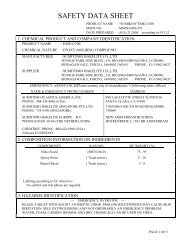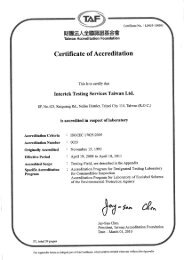Smart Grid Solutions Guide - Maxim
Smart Grid Solutions Guide - Maxim
Smart Grid Solutions Guide - Maxim
Create successful ePaper yourself
Turn your PDF publications into a flip-book with our unique Google optimized e-Paper software.
CommunicationsOverviewTable 1: <strong>Smart</strong> grid communications protocolsNetwork Protocol Advantages Disadvantages RecommendationWANWireless (2G/3G/LTEcellular, GPRS)Extensive cellular infrastructure is readilyavailable; large amount of aggregated datacan be communicated over a long haulUtility must rent the infrastructure from acellular carrier for a monthly access fee; utilitydoes not own infrastructureNAN Wireless ISM Long range; leaps transformers Currently proprietary; dead spots complicateinstallation and maintenanceWireless usually works bestUseful in some topologies, such as in theU.S.IEEE ® 802.15.4g Long range; leaps transformers Not yet an accepted standard Useful in some topologiesZigBee ®First-generation PLC(FSK, Yitran, Echelon ® )Early-generationnarrowband OFDMLow cost; low power consumption allowsbattery operation; well-known standardLow data rate; very short range; does notpenetrate structures wellUnlikely to be used in NANsLow cost Unreliable; low bandwidth Bandwidth and reliability inadequate forthe smart gridBetter range, bandwidth, and reliabilitythan FSKDoes not cross transformers; does not coexistwith first-generation PLCNot recommended for new designs due tocost and compatibility concernsBroadband PLC High data rate Does not cross transformers Increases infrastructure cost, making it toocostly for most large-scale deploymentsG3-PLCHighly reliable long-range transmission;crosses transformers, reducinginfrastructure costs; data rate supportsfrequent two-way communications;coexists with FSK; open standard;supports IPv6HAN ZigBee Well-known standard that offers low costand low powerNot yet an accepted standardVery short range; does not penetratestructures wellWi-Fi ® Popular technology with high data rates Medium range; does not penetrate cementbuildings or basementsFirst-generation PLC(FSK, Yitran, Echelon)Early-generationnarrowband OFDMExcellent for NAN worldwideWell suited for communication betweenwater and gas metersGood for consumer applications, but noprovisions for meeting utility objectivesLow cost Not reliable in home environments Unlikely to be used in homes due to highlevels of interferenceBetter range, bandwidth, and reliabilitythan FSKDoes not cross transformers; does not coexistwith first-generation PLCNot recommended for new designs due tocost and compatibility concernsBroadband PLC High bandwidth Short range is not sufficient for NAN Good for consumer applications, but noprovisions for meeting utility objectivesG3-PLCHighly reliable; sufficient data rate; IPv6enables networking with many devicesNot yet an accepted standardExcellent for HAN worldwideThe WAN is the communications pathbetween the grid operator and theconcentrator. The WAN can be implementedover fiber or wireless mediausing Ethernet or cellular protocols,respectively. Cellular or WiMAX® ismost commonly used between thegrid operator and the concentrator.The NAN is the path between theconcentrator and the meter. It useseither wireless or PLC. Typically, theconcentrator communicates withanywhere from a few to hundredsof meters, depending on the gridtopology and the communicationsprotocol used. Today, thereis no standard for this portion ofthe network, so most implementationsuse proprietary wireless orPLC technologies. Several standardsbodies are currently working withutilities and technology providersto define standards for wirelessand PLC protocols. The IEEE802.15.4g standard targets wireless;the IEEE P1901, OPEN meter, andITU-T G.hnem standards are beingdeveloped for PLC (Table 2).The HAN is used by utilities to extendthe reach of their communicationpath to devices inside the home.This network can support functionssuch as cycling air conditioners offduring peak load conditions, sharingconsumption data with in-homedisplays, or enabling a card-activatedprepayment scheme. The arrivalof electric/plug-in hybrid electricvehicles (EV/PHEVs) presents a specialcommunications scenario for HANs.Standards bodies are defining PLCprotocols for communicating withvehicle charging systems.In addition to supporting the datarequirements for smart grid activities,a HAN might also include: peer-topeer(P2P) communications betweendevices inside the home; communicationswith handheld remote-controldevices, lighting controls, and gas orwater meters; as well as broadband26 <strong>Maxim</strong> <strong>Smart</strong> <strong>Grid</strong> <strong>Solutions</strong>




